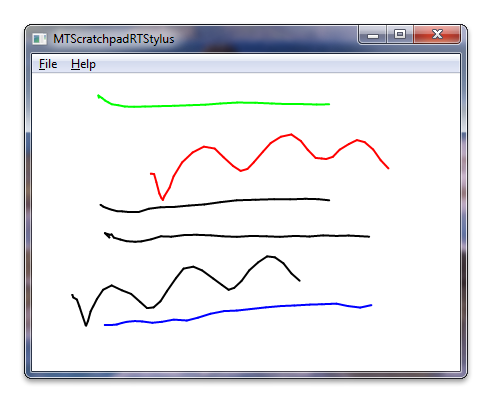Windows Touch Scratchpad con el ejemplo de lápiz en tiempo real (C++)
La muestra de Windows Touch Scratchpad (MTScratchpadRTStylus) muestra cómo usar mensajes de Windows Touch para dibujar seguimientos de los puntos táctiles en una ventana. El rastro del dedo primario, el que se puso en el digitalizador primero, se dibuja en negro. Los dedos secundarios se dibujan en seis otros colores: rojo, verde, azul, cian, magenta y amarillo. En la captura de pantalla siguiente se muestra el aspecto de la aplicación mientras se ejecuta.

Para este ejemplo, se crea el objeto Stylus (RTS) en tiempo real y se habilita la compatibilidad con varios puntos de contacto. Se agrega un complemento DynamicRenderer al RTS para representar el contenido. Un complemento, CSyncEventHandlerRTS, se implementa para rastrear el número de dedos y cambiar el color que está dibujando el representador dinámico. Con ambos complementos en la pila del complemento RTS, la aplicación Windows Touch Scratchpad representará el contacto principal en negro y el resto de los contactos en los distintos colores.
El código siguiente muestra cómo se crea el objeto RTS con compatibilidad con varios puntos de contacto.
IRealTimeStylus* CreateRealTimeStylus(HWND hWnd)
{
// Check input argument
if (hWnd == NULL)
{
ASSERT(hWnd && L"CreateRealTimeStylus: invalid argument hWnd");
return NULL;
}
// Create RTS object
IRealTimeStylus* pRealTimeStylus = NULL;
HRESULT hr = CoCreateInstance(CLSID_RealTimeStylus, NULL, CLSCTX_ALL, IID_PPV_ARGS(&pRealTimeStylus));
if (FAILED(hr))
{
ASSERT(SUCCEEDED(hr) && L"CreateRealTimeStylus: failed to CoCreateInstance of RealTimeStylus");
return NULL;
}
// Attach RTS object to a window
hr = pRealTimeStylus->put_HWND((HANDLE_PTR)hWnd);
if (FAILED(hr))
{
ASSERT(SUCCEEDED(hr) && L"CreateRealTimeStylus: failed to set window handle");
pRealTimeStylus->Release();
return NULL;
}
// Register RTS object for receiving multi-touch input.
IRealTimeStylus3* pRealTimeStylus3 = NULL;
hr = pRealTimeStylus->QueryInterface(&pRealTimeStylus3);
if (FAILED(hr))
{
ASSERT(SUCCEEDED(hr) && L"CreateRealTimeStylus: cannot access IRealTimeStylus3");
pRealTimeStylus->Release();
return NULL;
}
hr = pRealTimeStylus3->put_MultiTouchEnabled(TRUE);
if (FAILED(hr))
{
ASSERT(SUCCEEDED(hr) && L"CreateRealTimeStylus: failed to enable multi-touch");
pRealTimeStylus->Release();
pRealTimeStylus3->Release();
return NULL;
}
pRealTimeStylus3->Release();
return pRealTimeStylus;
}
En el código siguiente se muestra cómo se crea el complemento de representador dinámico y se agrega al RTS.
IDynamicRenderer* CreateDynamicRenderer(IRealTimeStylus* pRealTimeStylus)
{
// Check input argument
if (pRealTimeStylus == NULL)
{
ASSERT(pRealTimeStylus && L"CreateDynamicRenderer: invalid argument RealTimeStylus");
return NULL;
}
// Get window handle from RTS object
HWND hWnd = NULL;
HRESULT hr = pRealTimeStylus->get_HWND((HANDLE_PTR*)&hWnd);
if (FAILED(hr))
{
ASSERT(SUCCEEDED(hr) && L"CreateDynamicRenderer: failed to get window handle");
return NULL;
}
// Create DynamicRenderer object
IDynamicRenderer* pDynamicRenderer = NULL;
hr = CoCreateInstance(CLSID_DynamicRenderer, NULL, CLSCTX_ALL, IID_PPV_ARGS(&pDynamicRenderer));
if (FAILED(hr))
{
ASSERT(SUCCEEDED(hr) && L"CreateDynamicRenderer: failed to CoCreateInstance of DynamicRenderer");
return NULL;
}
// Add DynamicRenderer to the RTS object as a synchronous plugin
IStylusSyncPlugin* pSyncDynamicRenderer = NULL;
hr = pDynamicRenderer->QueryInterface(&pSyncDynamicRenderer);
if (FAILED(hr))
{
ASSERT(SUCCEEDED(hr) && L"CreateDynamicRenderer: failed to access IStylusSyncPlugin of DynamicRenderer");
pDynamicRenderer->Release();
return NULL;
}
hr = pRealTimeStylus->AddStylusSyncPlugin(
0, // insert plugin at position 0 in the sync plugin list
pSyncDynamicRenderer); // plugin to be inserted - DynamicRenderer
if (FAILED(hr))
{
ASSERT(SUCCEEDED(hr) && L"CreateDynamicRenderer: failed to add DynamicRenderer to the RealTimeStylus plugins");
pDynamicRenderer->Release();
pSyncDynamicRenderer->Release();
return NULL;
}
// Attach DynamicRenderer to the same window RTS object is attached to
hr = pDynamicRenderer->put_HWND((HANDLE_PTR)hWnd);
if (FAILED(hr))
{
ASSERT(SUCCEEDED(hr) && L"CreateDynamicRenderer: failed to set window handle");
pDynamicRenderer->Release();
pSyncDynamicRenderer->Release();
return NULL;
}
pSyncDynamicRenderer->Release();
return pDynamicRenderer;
}
El código siguiente cambia el color de trazo del lápiz óptico para el controlador de eventos StylusDown en CSyncEventHandlerRTS, un complemento RTS personalizado.
HRESULT CSyncEventHandlerRTS::StylusDown(
IRealTimeStylus* /* piRtsSrc */,
const StylusInfo* /* pStylusInfo */,
ULONG /* cPropCountPerPkt */,
LONG* /* pPacket */,
LONG** /* ppInOutPkt */)
{
// Get DrawingAttributes of DynamicRenderer
IInkDrawingAttributes* pDrawingAttributesDynamicRenderer;
HRESULT hr = g_pDynamicRenderer->get_DrawingAttributes(&pDrawingAttributesDynamicRenderer);
if (FAILED(hr))
{
ASSERT(SUCCEEDED(hr) && L"CSyncEventHandlerRTS::StylusDown: failed to get RTS's drawing attributes");
return hr;
}
// Set new stroke color to the DrawingAttributes of the DynamicRenderer
// If there are no fingers down, this is a primary contact
hr = pDrawingAttributesDynamicRenderer->put_Color(GetTouchColor(m_nContacts == 0));
if (FAILED(hr))
{
ASSERT(SUCCEEDED(hr) && L"CSyncEventHandlerRTS::StylusDown: failed to set color");
pDrawingAttributesDynamicRenderer->Release();
return hr;
}
pDrawingAttributesDynamicRenderer->Release();
++m_nContacts; // Increment finger-down counter
return S_OK;
}
Cuando se incrementa el valor de m_nContacts , cambiará el color establecido en el representador dinámico. Los trazos que no son el contacto principal se dibujarán con colores diferentes.
Temas relacionados
Aplicación de panel temporal multitáctil (RTS/C#),, Aplicación de panel temporal multitáctil (RTS/C++), muestras táctiles de Windows